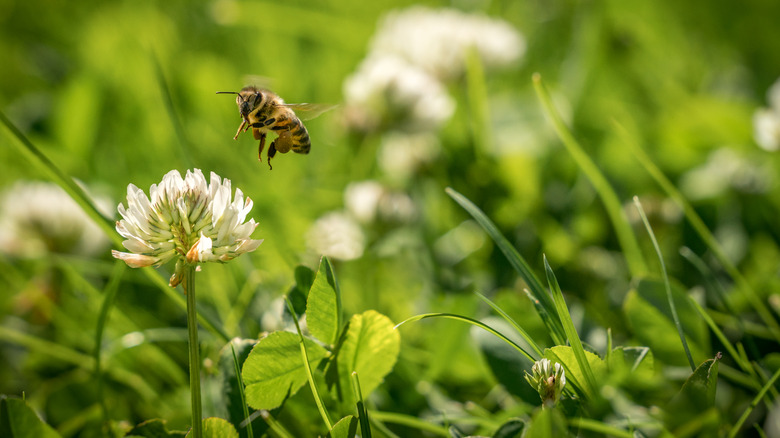The Simple Solution For Filling In Those Patchy Spots In Your Lawn
No matter how beautiful your landscaping is, patchy brown spots on your grass can bring down the look of the entire yard. This can be frustrating as many grasses are challenging to grow consistently. Luckily, clover can easily fill in these brown patches, and sowing clover seeds can quickly help give you the lush green lawn you've been craving.
While perfectly maintained monoculture turf grass lawns have long been considered the ideal, that standard is beginning to change. Grass lawns are notoriously time and resource-intensive to care for, generally requiring aeration, regular mowing, multiple fertilizer applications per year, and regular watering during dry months. Even with all that labor, they are often still patchy, leaving you to wonder why your grass isn't growing. Additionally, turf grass regularly needs to be reseeded and can be challenging to establish, often requiring daily watering initially. These requirements often aren't realistic, especially in drought-prone areas with water restrictions.
The advantages of using clover seeds for lawns
Clover has multiple advantages over grass for filling in bare spots on lawns. Unlike turf grass which requires regular nitrogen fertilizer, clover is actually a nitrogen fixer. Thanks to a symbiotic relationship with the Rhizobium bacteria in its roots, it can turn nitrogen from the atmosphere into a form that clover and other plants can use. Clover can also help decrease soil compaction and improve soil health. Additionally, clover's deeper roots mean it requires less watering than turf grass and is generally more drought tolerant. While clover is easy to grow, it does require full sun to thrive.
Both white clover (Trifolium repens) and micro-clover (Trifolium repens var. Pirouette and Pipolina) are popular options for growing a clover lawn and can quickly fill in patchy spots. When mixed in with grass they can also handle foot traffic relatively well and are hardy in USDA zones 3 through 13. Micro-clover has fewer flowers than white clover, making it less likely to attract bees. While this may be a disadvantage for those hoping to attract pollinators, it can be a major advantage for those with allergies or young children who are often in the yard.
Planting and maintaining clover lawns
Clover is best sowed in fall, though spring sowing is also an option. If you wish, you can buy clover seeds that have been inoculated with Rhizobium bacteria, or you can inoculate the seeds yourself. This will help ensure your clover's nitrogen-fixing ability. For small patches, you can easily scatter the seeds by hand, but a broadcast spreader may be helpful for seeding larger areas.
Both clover and micro-clover can grow to a height of about 8 inches but respond well to mowing, and you can easily keep them at a height of 4 inches. If you don't allow your clover to flower and go to seed, then you may need to reseed every year. Clover seeds can also be mixed with traditional grass seeds like fescue to fill in patchy lawn areas. This combines the advantages of clover with the more traditional appearance of a turf grass lawn, and the clover can help fertilize and support the grass.


